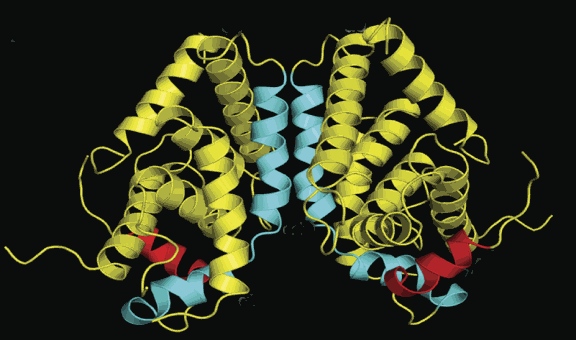The molecular structure of a nuclear receptor that regulates the expression of specific genes within cells may serve as a drug target for diseases related to heart and blood-vessel development, human embryonic development, and female infertility, according to a team of researchers from the Van Andel Institute (VAI), Grand Valley State University, Global Phasing Ltd., and Baylor College of Medicine. The researchers, using an x-ray beamline at the U.S. Department of Energy’s Advanced Photon Source (APS) at Argonne National Laboratory, also found that the receptor, named COUP-TFII, is activated by retinoic acid, a form of Vitamin A.
"Not only does the structural information provide a basis for drug design in any diseases where COUP-TFII plays a role, but it also can provide insight into the entire subfamily of receptors to which COUP-TFII belongs, which could have implications for additional associated diseases," said Eric Xu of VAI, who with his colleagues authored the article on this study that was published in PLoS Biology.
The researchers determined the molecular structure of COUP-TFII via x-ray crystallography carried out at the DuPont-Northwestern-Dow Collaborative Access Team 5-ID-B,C,D beamline at the APS. Structural information such as this can help drug developers fit therapeutics more perfectly to the receptors they bind to for maximum potency, and can also aid in manipulating drugs to produce fewer side effects.
The findings could also have implications for cancer therapy. "Since COUP-TFII plays a role in embryonic blood vessel development, it might play a similar role in tumors and cancer growth," said Schoen Kruse, also from VAI and lead author of the study. "Formation of new blood supply in tumors is a stepping stone in the ability of cancers to grow and metastasize within the body."
The signal-triggering molecules, known as ligands — which activate nuclear receptors — have been discovered for most receptors, but not for a subset of “orphan” nuclear receptors whose ligand remains unknown. This study's finding that COUP-TFII is activated by retinoic acid is significant since the receptor previously belonged to this subset of orphan receptors.
Contact: H. Eric Xu, eric.xu@vai.org
See: Schoen W. Kruse, Kelly Suino-Powell, X. Edward Zhou, Jennifer E. Kretschman, Ross Reynolds, Clemens Vonrhein, Yong Xu, Liliang Wang, Sophia Y. Tsai, Ming-Jer Tsai, and H. Eric Xu, ‘Identification of COUP-TFII Orphan Nuclear Receptor as a Retinoic Acid–Activated Receptor,” PLoS Biology 6 (9), e277 (September 2008).
The original press release can be found here.
This work was supported in part by the Jay and Betty Van Andel Foundation (H.E.X.), National Institutes of Health Grants DK71662, DK66202, and HL89301 to H.E.X., DK45641 and HD17379 to M.J.T., and HL076448 and P01-DK59820 (project 1) to S.Y.T. Use of the LS-CAT at APS was supported by the Office of Science of the U. S. Department of Energy and the Michigan Economic Development Corporation and the Michigan Technology Tri-Corridor (Grant 085P1000817). Use of the Advanced Photon Source at Argonne National Laboratory was supported by the U. S. Department of Energy, Office of Science, Office of Basic Energy Sciences, under Contract No. DE-AC02-06CH11357.
Argonne National Laboratory brings the world's brightest scientists and engineers together to find exciting and creative new solutions to pressing national problems in science and technology. The nation's first national laboratory, Argonne conducts leading-edge basic and applied scientific research in virtually every scientific discipline. Argonne researchers work closely with researchers from hundreds of companies, universities, and federal, state and municipal agencies to help them solve their specific problems, advance America 's scientific leadership and prepare the nation for a better future. With employees from more than 60 nations, Argonne is managed by UChicago Argonne, LLC for the U.S. Department of Energy's Office of Science.

